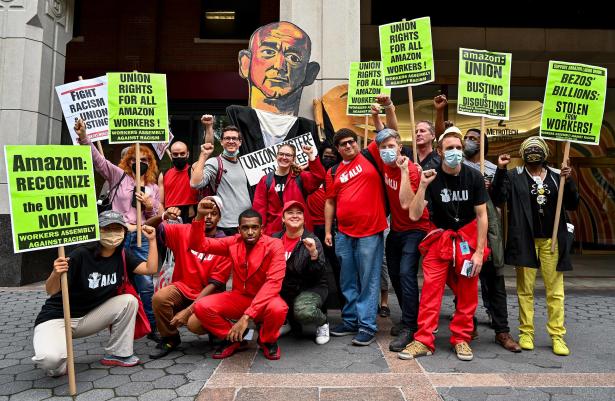2022 saw an unprecedented rise in labor organizing in U.S. tech firms, with some workers pushing for collective rights just as a tanking economy changed the industry's dynamics.
Yes, but: So far, tech's labor activism has largely moved on the margins of the industry, with Amazon warehouse workers, Apple Store employees and video game QA testers leading organizing efforts, while engineers, product teams and other headquarters staff mostly shied away.
Where Tech Workers Organized in 2022
The staff at a Staten Island Amazon warehouse in April voted to form the retail giant’s first union in the U.S. after workers voted against unionization last year in Alabama.
- In May, a second Staten Island warehouse voted to reject a union, and an upstate New York warehouse did the same in October. But new efforts continue to pop up, most recently in North Carolina and Kentucky.
Workers at several Apple Stores voted to unionize this year, including at Apple’s flagship store in New York City's Grand Central Terminal in April, a store in Maryland in June and a store in Oklahoma City in October.
- A retail store in Atlanta canceled a vote to unionize with workers there reportedly saying they felt intimidated, and last week the National Labor Relations Board accused Apple of using union-busting tactics at the location.
Collective action pressure within the video game industry has been building for years, with workers citing punishing schedules and hostile work environments. 2022 saw the first U.S. union formed in a big game publisher.
- Raven Software, owned by Activision Blizzard, unionized in May after the NLRB ruled against an Activision Blizzard challenge to the vote. Testers at Activision Blizzard Albany unionized this month.
Those moves mean that Microsoft, which still hopes to close its acquisition of Activision Blizzard despite regulatory challenges, will soon become a union employer.
- In June, Microsoft announced it had reached a "neutrality pact" with the union that has organized Activision workers and pledged not to interfere with unionization drives.
- Last week, hundreds of workers in the ZeniMax Studio Group, which Microsoft purchased for $7.5 billion in 2020, announced they were taking steps to vote on unionization.
- “We remain committed to providing employees with an opportunity to freely and fairly make choices about their workplace representation,” a Microsoft spokesperson told Axios.
Tech's History of Rejecting Unions
Zoom out: Tech’s outburst of organizing overcame decades of Silicon Valley resistance to labor unions.
- The industry rose in the '80s and '90s in an era dominated by free-market ideas. Most tech leaders and many workers saw unions as a relic of the analog past, a drag on the economy and a constraint on their flexibility and efficiency.
- The tech industry operates under an implicit bargain with skilled workers: They get stock option ownership and high pay in return for keeping the workplace union-free.
Today, however, the wider public has warmed to unions.
- An August 2022 Gallup poll found that U.S. approval of labor unions is at its highest point since 1965.
At the same time, the pull of the tech-firm stock-option magnet has weakened, at least briefly, as the industry faces its worst downturn in two decades.
The Union Perspective
What they’re saying: “The rate of organizing and the significance of the wins that we're seeing is like nothing I've experienced in my lifetime,” Sara Steffens, secretary-treasurer of the Communications Workers of America, which has been involved in several tech organization efforts, told Axios.
- Steffens attributed 2022's rise in tech unions to pandemic-driven cultural shifts and long- germinating efforts to organize.
- “When you have a QA tester who's just killing themselves at crunch time, really taking on a crazy amount of work and all the health burdens that go along with that, they can understand that they're being exploited,” Steffens said.
- Amazon, Apple, Activision Blizzard and the NLRB declined to comment for this story.
Steffens praised Microsoft's approach as “showing the other tech companies that there's a different way to do this, besides digging in and fighting — that you could actually support your workers rights to make this decision on their own through an orderly process.”
- “I think that people will see that it's turned out to be a really good thing business-wise for Microsoft.”
What's Next: Negotiating Contracts Amid Layoffs
Tech's labor organizing is still in its infancy.
- Only a few unions have successfully formed, and most of those still face the often-arduous process of negotiating contracts with employers.
Pandemic-driven labor shortages gave workers an unusual boost in leverage for a time, but that dynamic could change again as the economy slows down.
- The tech industry laid off over 120,000 employees in 2022.
The bottom line: Steffens predicts that the “exponential” momentum built in 2022 will continue in 2023.


Spread the word